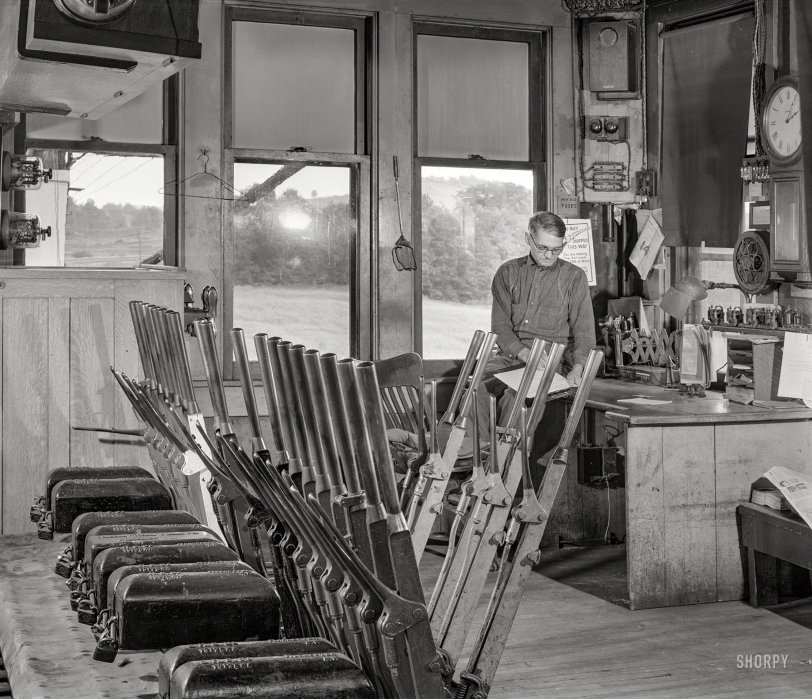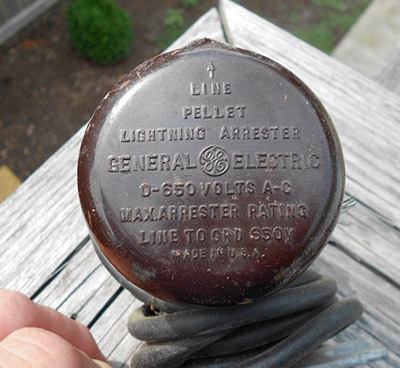


Framed or unframed, desk size to sofa size, printed by us in Arizona and Alabama since 2007. Explore now.
Shorpy is funded by you. Patreon contributors get an ad-free experience.
Learn more.

- Freeze Frame
- Texas Flyer wanted
- Just a Year Too Soon
- WWII -- Replacing men with women at the railroad crossing.
- Yes, Icing
- You kids drive me nuts!
- NOT An Easy Job
- I wonder
- Just add window boxes
- Icing Platform?
- Indiana Harbor Belt abides
- Freezing haze
- Corrections (for those who care)
- C&NW at Nelson
- Fallen Flags
- A dangerous job made worse
- Water Stop
- Passenger trains have right of way over freights?
- Coal
- Never ceases to amaze me.
- Still chuggin' (in model form)
- Great shot
- Westerly Breeze
- For the men, a trapeze
- Tickled
- Sense of loneliness ...
- 2 cents
- Charm City
- What an Outrage
- Brighton Park
Print Emporium
R.R. Control Tower: 1940

September 1940. "Mr. T.J. Long, president of the Tri-County Farmers Co-op Market in Clearfield County, Pennsylvania, at his work in a railroad tower near Du Bois." Medium format acetate negative by Jack Delano. View full size.
Lightning arrester
Surge protectors were also referred to as lightning arresters.
That's what I see under the two bells behind him. I also think the two glass covers in the left of the photo are some sort of protection as well.
I picked several porcelain GE ones while insulator hunting in Kansas several years ago.

Restricted Access
The padlocks on the the switch machine ensure that only authorized switch and signal maintainers have access to the internal mechanism for maintenance purposes. Note that there also "car seals" applied in addition to the padlocks. This is an additional "tamper-evident" security measure. Yes, this compartmentalization is something on a par with ballistic missile systems. These switch control mechanisms are that important.
Locked Boxes
The boxes on the left house electric locks. They mechanically lock the levers depending on electrical circuits, such as track circuits used to detect the presence of a train. These locks are safety critical, and so must be kept secure from unauthorized access -- hence the locks. Only signal maintainers would have a key; the towerman would not be able to release the locks and cause an unsafe condition.
Those Locked Boxes
Those are electrical switches, actuated by the huge levers, used to control signals or other devices, but not the track switches.
The levers to the right are used by the Operator (that's his job title) to set up or take down routes of trains though the Junction. One lever controls one track switch or signal.
A system of sliding bars and levers under the floor interconnects these levers and prevents the operator from setting up conflicting routes through the junction, and only after setting up a clear route could the levers which controlled the signals for that route be actuated.
A system of rods an levers, up to a mile long, connected to each track switch to one of the levers at the operators disposal. These required great force to be moved - more than available from the battery powered electric motors of the time. Signals didn't require so much power to operate, and could be battery powered, thus the locked boxes on the "locking frame" to control signals. The locks were removed only by maintainers, not by the operator.
Restoration & Repurposing
It's nice to see some effort to preserve railroad towers. I'll have to swing by North Judson to see if their efforts were realized. http://www.grassellitower.com/towers.htm
Then, if I ever get back to Milwaukee, I'd like to take a look at this sturdy "tiny house" conversion: https://urbanmilwaukee.com/2017/08/24/house-confidential-tiny-railroad-t...
Locks
Wonder why those boxes on the left are locked? Does he have to unlock them to switch the switches each time?
Some things old can be renewed
Those "old" fuses may have renewable links. I remember seeing some of those years ago.
Renewable Fuses
Not all fuses are one use only. Some are cylinders that can be opened, and a new fusible link or wire installed, inside the original unit. I would suggest that is a possible explanation for the "new and old" fuse container. There were probably a few blown fuses in the old section ready for renewing. You can read about it here.
If you remember the Beatles song "When I'm Sixty-four", one of the lyrics is: "I could be handy mending a fuse when your lights have gone." England and Australia used renewable porcelain fuses in older homes, and they could be "mended" by threading the correct amperage fuse wire through them.
Old fuses could be new again.
The cartridge fuses like those to the left of the clock were not disposable. The end caps where removable to facilitate replacing the fusible link inside. I've seen really big ones that would take two hands to pick up.
New Old Fuses
The fusible links in some barrel type fuses can be replaced by unscrewing the end caps, removing the blown parts, putting in a new link, and replacing the end caps.
This may be the situation here.
New and Old; and More
Once upon a time, fuses could be repaired. The case could be opened and the internal element (sometimes a thin wire, sometimes a stamped piece of metal) could be replaced. Thus, you would have to save the 'old' fuses.
Interesting that there are two interlocking machines here. The obvious one in the foreground is a mechanical interlocking machine, where the switches and signals were mechanically connected to the levers. The power to operate the equipment was provided by the towerman's arms - hence the colloquial term "armstrong machine". The five levers leaning out (to the right) are lock levers, painted blue, which lock switches. Before throwing the switch, the lock lever has to be returned to the "normal" position, in line with the other levers.
The other interlocking machine is just visible at the left, in the large wooden box. It is a General Railway Signal power machine, where the switches and signals are operated by electric motors (in this case). The levers are still mechanically locked between each other, but the use of external power made the levers much easier to operate.
In a few instances, electric and mechanical machines were mechanically interconnected, but not in this case.
New Fuses for old circuits
The old fuses were to fit the old fuseholders, which are the porcelain blocks just to the right of the "New Old Fuses" container. The fuses are the long slender porcelain tubes, two of which are clipped into each block. I remember seeing these on old telephone lightning arrestors. Conspicuous by their absence are the spares; there are none in the box.
Re: Everything Old is New Again
I'm imagining that the pouch is divided; new fuses go in the left compartment, and old ones in the right. Question then is why don't the old ones just go in the trash?
Quiet Please
Keep it down out there! Our Block Operator may be copying an important message from up or down the line. By the look of things with six telegraph sounders at his desk, a phone and "patch" panels and one lone telegraph key, at times Mr. Long can be a busy man.
B&O facilities
DuBois was a significant maintenance point for the Baltimore & Ohio (ex-Buffalo, Rochester and Pittsburgh), with a roundhouse, engine repair shop capable of heavy overhauls, and car repair shop. The town also served as a division point, as well as a connection to the New York Central & Hudson River.
Dust and Old Paint
I'm old enough to remember workplaces like this when I was a kid and tagged along with my dad. Those windows in Winter let in cold air like you would not believe, but couldn't have shades as that obstructed the view. The tower I remember was on stilts to facilitate looking way up and down the tracks, and seeing the color of the track signals. Wind whistled around its uninsulated walls. There was a pot-bellied stove that burned coal. The place was swept sometimes but still had decades of accumulated dust. Paint was a yellow-brown color made browner by dirt. In other offices the paint was battleship grey. The fellow who sat in the observation office most often was peculiar and I wasn't supposed to be left alone with him. When I was told that it terrified me and I avoided looking at him. Maybe that's why I remember it so well.
His Last September
Mr. Thomas Jackson Long, as of the 1940 census, was a 56-year-old railroad telegraph operator living in Sandy Township with his wife and two adult children. Sadly, he died three months after this photo was taken, shot in a hunting accident.
Everything Old is New Again
The pouch on the wall labeled "New Old Fuses" is intriguing. One wonders if there is a similar one out of frame labeled "Old New Fuses".
























On Shorpy:
Today’s Top 5